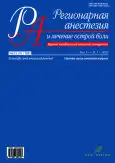Влияние регионарной анестезии как компонента мультимодального обезболивания на когнитивный статус пациентов в офтальмохирургии
- Авторы: Дорофеева Г.С.1, Кобеляцкий Ю.Ю.2
-
Учреждения:
- Днепропетровская областная клиническая офтальмологическая больница
- Днепропетровская медицинская академия
- Выпуск: Том 15, № 1 (2021)
- Страницы: 49-56
- Раздел: Оригинальные статьи
- URL: https://journals.rcsi.science/1993-6508/article/view/75946
- DOI: https://doi.org/10.17816/1993-6508-2021-15-1-49-56
- ID: 75946
Цитировать
Аннотация
Цель исследования. проанализировать состояние центральной нервной системы (ЦНС), динамику изменений когнитивных функций в послеоперационном периоде у пациентов, перенëсших операцию «сквозная кератопластика». Оценить влияние выбранного метода анестезии на формирование послеоперационных когнитивных дисфункций.
Материалы и методы. Анализ когнитивного статуса проводился при помощи нейропсихологического тестирования: шкала лобных дисфункций (Frontal Assessment Battery – FAB), короткая шкала оценки психического статуса (Mini-MentalStateExamination – MMSE). Оценка результатов проводилась накануне операции, через 6 ч после оперативного вмешательства, через 7 и 21 день после операции. В зависимости от использованного метода анестезии были выделены следующие группы: 1-я группа – за 20 мин до оперативного вмешательства была выполнена блокада крылонëбной ямки в добавление к ОА; 2-я группа – общая анестезия (ОА) с применением дексмедетомидина инфузионно за 40 мин до оперативного вмешательства. Поддержание анестезии проводилось севофлуран-кислородной смесью на низком потоке газа. Группы статистически сопоставимы по возрасту и полу. Глубина анестезии и седации оценивалась при помощи показателей индекса BIS (Bispectralindex, биспектральний индекс) и ANI (Аnalgesia Nociception Index, индекс анальгезии при ноцицепции) соответственно.
Результаты. Во 2-й группе по результатам тестирования по шкалам MMSE и FAB когнитивные показатели в первые 6 ч после оперативного вмешательства были выше, чем в 1-й группе, однако к 21-м сут эти показатели мало разнились (p < 0,05). Так, в 1-й группе через 6 ч после операции отмечалось снижение показателей по шкале MMSE на 20,8%, по шкале FAB – на 28,6% от исходного уровня. Во 2-й группе на этом же этапе исследования показатели по шкале MMSE были снижены на 8,3%, по шкале FAB – на 13,3%. При проведении тестирования через 21 день после оперативного вмешательства по этим же шкалам отмечается восстановление показателей когнитивных функций до исходного уровня в обеих группах.
Заключение. Уровень когнитивных дисфункций после операции у офтальмохирургических пациентов при применении регионарной анестезии и использовании дексмедетомидина существенно отличается в первые часы послеоперационного периода. Через 21 день нейропсихологический статус разнится незначительно (p > 0,05).
Ключевые слова
Полный текст
Открыть статью на сайте журналаОб авторах
Ганна Сергеевна Дорофеева
Днепропетровская областная клиническая офтальмологическая больница
Автор, ответственный за переписку.
Email: das1977@rambler.ru
ORCID iD: 0000-0001-8418-3243
аспирант
Украина, 49044, Днепр, ул. В. Вернадского 9Юрий Юрьевич Кобеляцкий
Днепропетровская медицинская академия
Email: kobeliatsky@ukr.net
ORCID iD: 0000-0002-8504-6125
д.м.н., профессор
Украина, 49044, Днепр, ул. В. Вернадского 9Список литературы
- Brown E.N., Pavone K.J., Naranjo M. Multimodal General Anesthesia: Theory and Practice // Anesth Analg. 2018. Vol. 127, N 5. P. 1246-1258. doi: 10.1213/ANE.0000000000003668
- Smith C.R., Helander E., Chheda N.N. Trigeminal Nerve Blockade in the Pterygopalatine Fossa for the Management of Postoperative Pain in Three Adults Undergoing Tonsillectomy: A Proof-of-Concept Report // Pain Medicine. 2020. Vol. 21, N 10. P. 2441-2446. doi: 10.1093/pm/pnaa062
- Kotekar N., Shenkar A., Nagaraj R. Postoperative cognitive dysfunction – current preventive strategies // Clin Interv Aging. 2018. Vol. 13, N. P. 2267-2273. doi: 10.2147/CIA.S133896
- Акименко Т.И., Женило В.М., Здирук С.В., Александрович Ю.С. Снижение частоты послеоперационных когнитивных нарушений после ампутации матки при ингаляционной анестезии севофлураном // Альманах клинической медицины. 2018. Т. 46, № 7. С. 699-707.
- Varin M., Kergoat M.J., Belleville S., et al. Age-Related Eye Disease and Cognitive Function: The Search for Mediators // Ophthalmology. 2020. Vol. 127, N 5. P. 660-666. doi: 10.1016/j.ophtha.2019.10.004
- De Oliveira G.S. Jr., Almeida M.D., Benzon H.T., McCarthy R.J. Perioperative single dose systemic dexamethasone for postoperative pain: a meta-analysis of randomized controlled trials // Anesthesiology. 2011. Vol. 115, N 3. P. 575-588. doi: 10.1097/ALN.0b013e31822a24c2
- Lee D.G. Idea on prevention from postoperative intraorbital hematoma in orbital surgery // Indian J Otolaryngol Head Neck Surg. 2014. Vol. 66, N Suppl 1. P. 323-325. doi: 10.1007/s12070-011-0449-6
- Криштафор А.А., Йовенко И.А., Черненко В.Г., и др. Особенности когнитивных нарушений при ранениях, полученных в условиях боевых действий // Медицина неотложных состояний. 2018. № 2. C. 81. doi: 10.22141/2224-0586.2.81.2017.99701
- Ayvardgi A.A. Kobeliatskyy Yu.Yu. ANI-monitoring in assessing the effectiveness of the anesthetic management for plastic surgery of the nose // Emergency medicine. 2018. Vol. 88. № 1. P. 103-107. doi: 10.22141/2224-0586.1.88.2018.124975
- Щуко А.Г., Юрьева Т.Н., Олещенко И.Г. Роль крыло-нёбной блокады в программе ранней реабилитации детей после хирурги и врождённой катаракты // Офтальмологические ведомости. 2017. Т. 10, № 4. C. 18–23. doi: 10.17816/OV10418-23
- Антомонов М.Ю. Математическая обработка и анализ медико-биологических данных. Киев: Мединформ, 2017.
Дополнительные файлы








